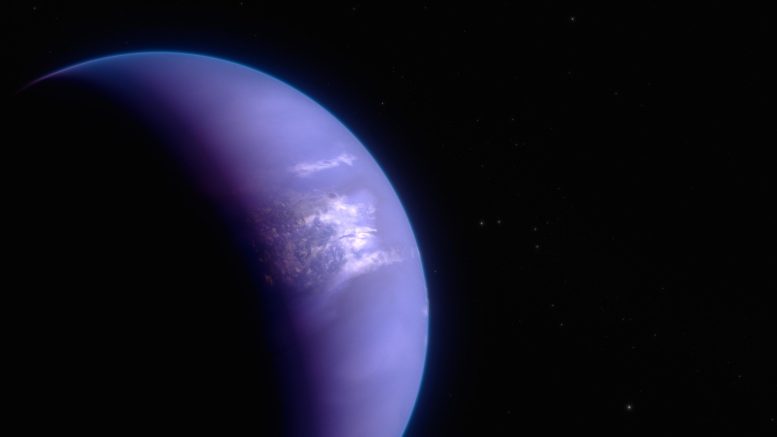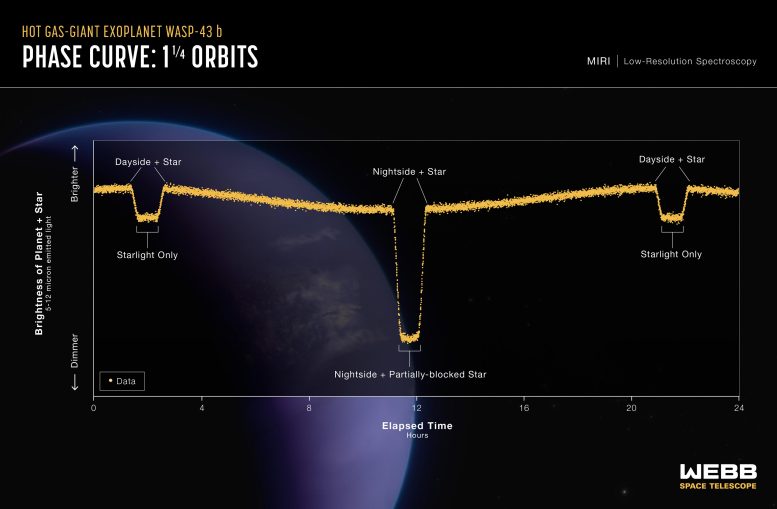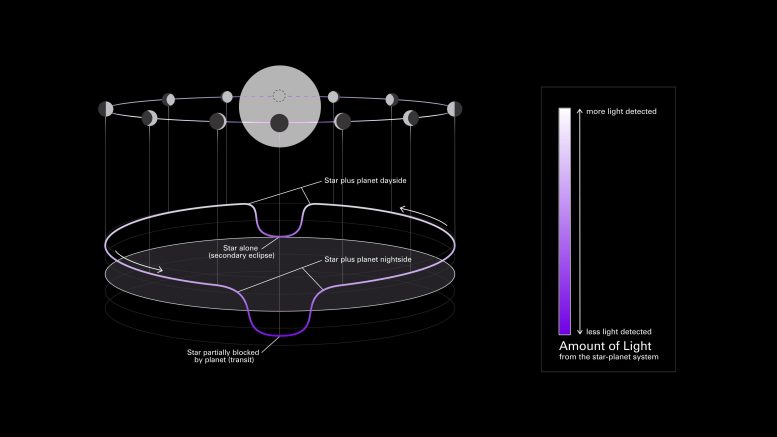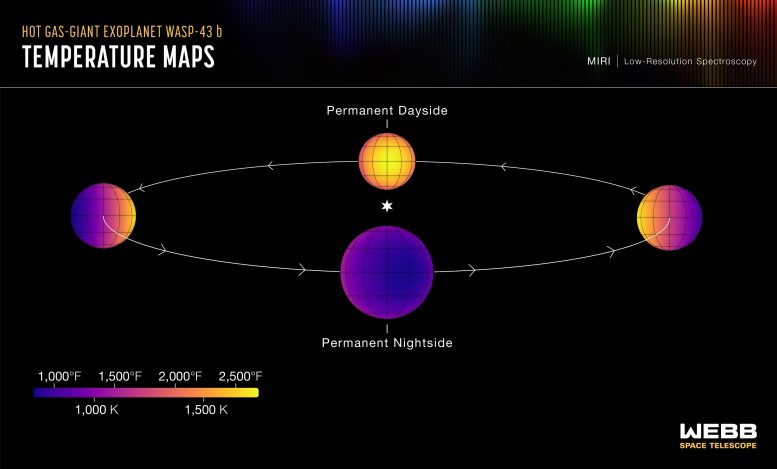This artist’s concept shows what the hot gas-giant exoplanet WASP-43 b could look like. WASP-43 b is a Jupiter-sized planet circling a star roughly 280 light-years away, in the constellation Sextans. The planet orbits at a distance of about 1.3 million miles (0.014 astronomical units, or AU), completing one circuit in about 19.5 hours. Because it is so close to its star, WASP-43 b is probably tidally locked: its rotation rate and orbital period are the same, such that one side faces the star at all times. Credit: NASA, ESA, CSA, Ralf Crawford (STScI)
WASP-43 b is cloudy on the nightside and clear on the dayside, with equatorial winds howling around the planet at 5,000 miles per hour.
Sometimes not finding something is just as exciting and useful as finding it. Take hot
This light curve shows the change in brightness of the WASP-43 system over time as the planet orbits the star. This type of light curve is known as a phase curve because it includes the entire orbit, or all phases of the planet.
Because it is tidally locked, different sides of WASP-43 b rotate into view as it orbits. The system appears brightest when the hot dayside is facing the telescope, just before and after the secondary eclipse when the planet passes behind the star. The system grows dimmer as the planet continues its orbits and the nightside rotates into view. After the transit when the planet passes in front of the star, blocking some of the starlight, the system brightens again as the dayside rotates back into view.
Credit: NASA, ESA, CSA, Ralf Crawford (STScI), Taylor Bell (BAERI), Joanna Barstow (The Open University), Michael Roman (University of Leicester)
Webb Space Telescope Maps Weather on Planet 280 Light-Years Away
An international team of researchers has successfully used exoplanet WASP-43 b.
Precise brightness measurements over a broad spectrum of mid-infrared light, combined with 3D climate models and previous observations from other telescopes, suggest the presence of thick, high clouds covering the nightside, clear skies on the dayside, and equatorial winds upwards of 5,000 miles per hour mixing atmospheric gases around the planet.
The investigation is just the latest demonstration of the Hubble, we could clearly see that there is water vapor on the dayside. Both Hubble and Spitzer suggested there might be clouds on the nightside,” explained Taylor Bell, researcher from the Bay Area Environmental Research Institute and lead author of a study published on April 30 in Nature Astronomy. “But we needed more precise measurements from Webb to really begin mapping the temperature, cloud cover, winds, and more detailed atmospheric composition all the way around the planet.”
This simplified diagram of an exoplanet phase curve shows the change in total brightness of a star–planet system as the planet orbits the star. The system looks brighter when more of the lit side of the planet is facing the telescope (full phase). It looks dimmer when more of the dark side is facing the telescope (new phase), when the planet is blocking some of the starlight (transit), and when light from the planet is blocked by the star (secondary eclipse).
(Top) Diagram showing the change in a planet’s phase (the amount of the lit side facing the telescope) as it orbits its star.
(Bottom) Three-dimensional graph showing the change in the total brightness of the star–planet system as the planet orbits its star. In this graph, known as a light curve, the horizontal plane is orbital location and the vertical axis is brightness.
(Right) Scale bar. In both the orbital diagram and the light curve, color indicates the observed brightness of the star + planet: from dark purple (less amount of light detected) to white (more light detected).
Researchers use phase curves to study variations in reflectivity and temperature of a planet with longitude (from one side to another), which can provide insight into the surface composition and atmospheric conditions of the planet.
Credit: NASA, ESA, CSA, Dani Player (STScI), Andi James (STScI), Greg Bacon (STScI)
Mapping Temperature and Inferring Weather
Although WASP-43 b is too small, dim, and close to its star for a telescope to see directly, its short orbital period of just 19.5 hours makes it ideal for phase curve spectroscopy, a technique that involves measuring tiny changes in brightness of the star-planet system as the planet orbits the star.
Since the amount of mid-infrared light given off by an object depends largely on how hot it is, the brightness data captured by Webb can then be used to calculate the planet’s temperature.
The team used Webb’s MIRI (Mid-Infrared Instrument) to measure light from the WASP-43 system every 10 seconds for more than 24 hours. “By observing over an entire orbit, we were able to calculate the temperature of different sides of the planet as they rotate into view,” explained Bell. “From that, we could construct a rough map of temperature across the planet.”
The measurements show that the dayside has an average temperature of nearly 2,300 degrees
This set of maps shows the temperature of the visible side of the hot gas-giant exoplanet WASP-43 b, as the planet orbits its star. The temperatures were calculated based on more than 8,000 brightness measurements of 5- to 12-micron mid-infrared light detected from the star-planet system by MIRI (the Mid-Infrared Instrument) on NASA’s James Webb Space Telescope. In general, the hotter an object is, the more mid-infrared light it gives off. Credit: NASA, ESA, CSA, Ralf Crawford (STScI), Taylor Bell (BAERI), Joanna Barstow (The Open University), Michael Roman (University of Leicester)




